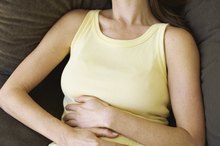What Is the Function of the Rectum?
The rectum is the end of the digestive tract, which begins at the mouth and includes the esophagus, stomach and small and large intestines. The rectum is about 6 to 8 inches long, and is the final portion of the large intestine leading into the anal canal.
Function
The main function of the rectum is to act as a temporary storage site for fecal matter before it is eliminated from the body through the anal canal. As the food you eat passes through the digestive system, it is broken down and nutrients are absorbed in the stomach, small and large intestines. Fecal matter, which includes digestive juices, bacteria and fiber, continues to move into the lower portion of the large intestine – the rectum. The rectum holds the feces until you push it out of the body, through the anal canal, by having a bowel movement.
- The main function of the rectum is to act as a temporary storage site for fecal matter before it is eliminated from the body through the anal canal.
Significance
What Things Are Found During a Colonoscopy?
Learn More
The rectum is made up of muscular walls that are able to expand to hold fecal matter. With this expansion of the rectum, nerves in the area send signals to the brain that you need to have a bowel movement and muscles in and around the anal canal control the action. Adults and older children are able to control these muscles, relaxing them to release the feces from the rectum or contracting them to avoid having a bowel movement.
Considerations
The rectum and anal canal contain a large number of veins, which, when swollen and inflamed, are called hemorrhoids. More than 50 percent of the American population will suffer from hemorrhoids by the age of 50. They can be painful, itchy and can bleed. Straining to have a bowel movement, diarrhea and constipation can all cause hemorrhoids. Sudden rectal bleeding should never be ignored, since it may be an indication of a more serious condition, including rectal cancer.
- The rectum and anal canal contain a large number of veins, which, when swollen and inflamed, are called hemorrhoids.
- Straining to have a bowel movement, diarrhea and constipation can all cause hemorrhoids.
Warning
Exercises to Strengthen the Colon Wall
Learn More
Rectal cancer affects over 40,000 people, and colon cancer affects over 100,000 in the United States – mostly those over the age of 50. Symptoms often go unnoticed, making colorectal cancers the second leading cause of cancer death. Symptoms include blood in the stool (bright red or dark red), small, narrow stool, abdominal pain, constipation or diarrhea. Talk to your doctor if you have any of these symptoms, and if you are over the age of 50, make sure you are screened regularly for colorectal cancer.
- Rectal cancer affects over 40,000 people, and colon cancer affects over 100,000 in the United States – mostly those over the age of 50.
- Talk to your doctor if you have any of these symptoms, and if you are over the age of 50, make sure you are screened regularly for colorectal cancer.
Prevention/Solution
You can help to prevent hemorrhoids and colorectal cancer by eating a healthy diet. Drink lots of water – 8 glasses a day – to help move food and waste through your body and assist in the absorption of nutrients. Eat fresh fruits and vegetables and whole grains, which provide essential nutrients to support the health of your body tissues and also provide good sources of fiber. Fiber traps toxins and helps to move waste products through the intestines, preventing constipation as well as diarrhea. If you are over the age of 50 or have a family history of cancer, have regular screening for rectal and colon cancers.
- You can help to prevent hemorrhoids and colorectal cancer by eating a healthy diet.
- Eat fresh fruits and vegetables and whole grains, which provide essential nutrients to support the health of your body tissues and also provide good sources of fiber.
Related Articles
Writer Bio
Dr. Nancy Steely is a Licensed Naturopathic Physician from world-renowned Bastyr University. Her international travels have allowed her to learn the ideologies and methodologies of practitioners around the globe. A former executive for a major nutraceutical manufacturer, Dr. Steely currently consults for the nutraceuticals/wellness industry. Writing since 2001, she has written for various websites and is a featured author in "A Healthier You!"









